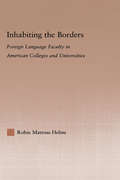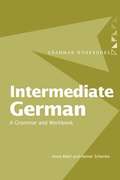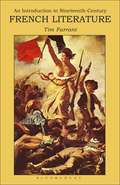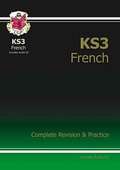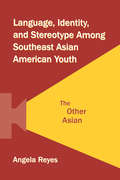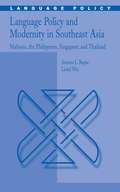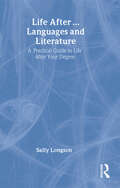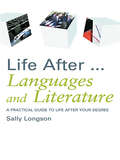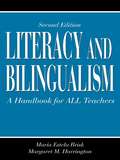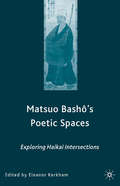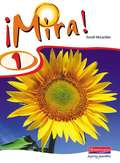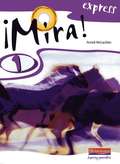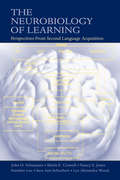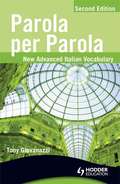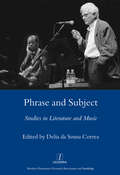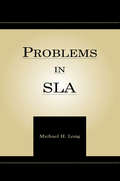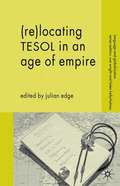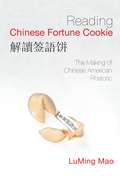- Table View
- List View
Inhabiting the Borders: Foreign Language Faculty in American Colleges and Universities (Studies in Higher Education)
by Robin Matross HelmsThis book focuses on the experience of foreign language faculty in American colleges and universities, the challenges they face, and ways that academia can better support language faculty, and marginalized faculty in other fields, in their important work.
Intermediate German: A Grammar and Workbook
by Anna Miell Heiner SchenkeIntermediate German is designed for learners who have achieved basic proficiency and now wish to progress to more complex language. Each of the units combines concise grammar explanations with examples and exercises to help build confidence and fluency. Features include: clear explanations of the similarities and differences in English and German grammar authentic language examples from a range of contemporary media checklists at the end of each unit for consolidation full cross-referencing throughout extra tips on language learning and learning specific grammar points. Suitable for students learning with or without a teacher, Intermediate German, together with its sister volume, Basic German, forms a structured course of the essentials of German grammar.
Introduction to Nineteenth-Century French Literature
by Tim FarrantEveryone knows something of nineteenth-century France - or do they? "Les Miserables", "The Lady of the Camelias" and "The Three Musketeers", "Balzac" and "Jules Verne" live in the popular consciousness as enduring human documents and cultural icons. Yet, the French nineteenth century was even more dynamic than the stereotype suggests. This exciting new introduction takes the literature of the period both as a window on past and present mindsets and as an object of fascination in its own right. Beginning with history, the century's biggest problem and potential, it looks at narrative responses to historical, political and social experience, before devoting central chapters to poetry, drama and novels - all genres the century radically reinvented. It then explores numerous modernities, ways nineteenth-century writing and mentalities look forward to our own, before turning to marginalities - subjects and voices the canon traditionally forgot. No genre was left unchanged by the nineteenth century. This book will help to discover them anew.
KS3 French Complete Revision & Practice with Audio CD (PDF)
by Cgp BooksThis book is full of key phrases, topic vocab and practice questions for year 7-9 French students so it's packed with everything you need to know for the current KS3 programme of study. To help you remember all the important bits, there are summary questions at the end of each section (answers at the back) and a CD packed with speaking and listening practice. It's easy to read and learn from - everything's explained simply, in CGP's chatty straightforward style.
Language, Identity, and Stereotype Among Southeast Asian American Youth: The Other Asian
by Angela ReyesThis book—an ethnographic and discourse analytic study of an after-school video-making project for 1.5- and second-generation Southeast Asian American teenagers—explores the relationships among stereotype, identity, and ethnicity that emerge in this informal educational setting. Working from a unique theoretical foundation that combines linguistic anthropology, Asian American studies, and education, and using rigorous linguistic anthropological tools to closely examine video- and audio- recorded interactions gathered during the video-making project (in which teen participants learned the skills for creating their own video and adult staff learned to respect and value the local knowledge of youth), the author builds a compelling link between micro-level uses of language and macro-level discourses of identity, race, ethnicity, and culture. In this study of the ways in which teens draw on and play with circulating stereotypes of the self and the other, Reyes uniquely illustrates how individuals can reappropriate stereotypes of their ethnic group as a resource to position themselves and others in interactionally meaningful ways, to accomplish new social actions, and to assign new meanings to stereotypes. This is an important book for academics and students in sociolinguistics, linguistic anthropology, discourse analysis, and applied linguistics with an interest in issues of youth, race, and ethnicity, and/or educational settings, and will also be of interest to readers in the fields of education, Asian American studies, social psychology, and sociology.
Language, Identity, and Stereotype Among Southeast Asian American Youth: The Other Asian
by Angela ReyesThis book—an ethnographic and discourse analytic study of an after-school video-making project for 1.5- and second-generation Southeast Asian American teenagers—explores the relationships among stereotype, identity, and ethnicity that emerge in this informal educational setting. Working from a unique theoretical foundation that combines linguistic anthropology, Asian American studies, and education, and using rigorous linguistic anthropological tools to closely examine video- and audio- recorded interactions gathered during the video-making project (in which teen participants learned the skills for creating their own video and adult staff learned to respect and value the local knowledge of youth), the author builds a compelling link between micro-level uses of language and macro-level discourses of identity, race, ethnicity, and culture. In this study of the ways in which teens draw on and play with circulating stereotypes of the self and the other, Reyes uniquely illustrates how individuals can reappropriate stereotypes of their ethnic group as a resource to position themselves and others in interactionally meaningful ways, to accomplish new social actions, and to assign new meanings to stereotypes. This is an important book for academics and students in sociolinguistics, linguistic anthropology, discourse analysis, and applied linguistics with an interest in issues of youth, race, and ethnicity, and/or educational settings, and will also be of interest to readers in the fields of education, Asian American studies, social psychology, and sociology.
Language Policy and Modernity in Southeast Asia: Malaysia, the Philippines, Singapore, and Thailand (Language Policy #6)
by Antonio L. Rappa Lionel Wee Hock AnThis original piece of research considers the ways in which modernity challenges and informs the language policies of various Southeast Asians nations. It combines theoretical arguments from policy studies, language policy and political theory, with quantitative figures where necessary. Succinctly and clearly written, this volume fills the research gap on the topic while bringing up to date the various political, social, and policy developments.
Life After...Languages and Literature: A practical guide to life after your degree
by Sally LongsonThousands of students graduate from university each year. The lucky few have the rest of their lives mapped out in perfect detail - but for most things are not nearly so simple. Armed with your hard-earned degree the possibilities and career paths lying before you are limitless, and the number of choices you suddenly have to make can seem bewildering. Life After a Languages and Literature Degree has been written specifically to help students currently studying, or who have recently graduated, make informed choices about their future. It will be source of invaluable advice and wisdom to graduates on where their degree can take them, covering such topics as: Identifying a career path that interests you – from journalism to interpretation Seeking out an opportunity that matches your skills and aspirations Staying motivated and pursuing your goals Networking and self-promotion Making the transition from scholar to worker The Life After University series of books are more than simple ‘career guides’. They are unique in taking a holistic approach to career advice – recognising the increasing view that, although a successful working life is vitally important, other factors can be just as essential to happiness and fulfilment. They are the indispensable handbooks for students considering their future direction.
Life After...Languages and Literature: A practical guide to life after your degree
by Sally LongsonThousands of students graduate from university each year. The lucky few have the rest of their lives mapped out in perfect detail - but for most things are not nearly so simple. Armed with your hard-earned degree the possibilities and career paths lying before you are limitless, and the number of choices you suddenly have to make can seem bewildering. Life After a Languages and Literature Degree has been written specifically to help students currently studying, or who have recently graduated, make informed choices about their future. It will be source of invaluable advice and wisdom to graduates on where their degree can take them, covering such topics as: Identifying a career path that interests you – from journalism to interpretation Seeking out an opportunity that matches your skills and aspirations Staying motivated and pursuing your goals Networking and self-promotion Making the transition from scholar to worker The Life After University series of books are more than simple ‘career guides’. They are unique in taking a holistic approach to career advice – recognising the increasing view that, although a successful working life is vitally important, other factors can be just as essential to happiness and fulfilment. They are the indispensable handbooks for students considering their future direction.
Literacy and Bilingualism: A Handbook for ALL Teachers
by Maria Estela Brisk Margaret M. HarringtonThis handbook applies proven techniques, derived from bilingual/bicultural classrooms, to teaching literacy in the twenty-first century. Its goal is to help teachers increase their understanding of bilingual learners in order to maximize instruction. Teachers can use this handbook to expand their understanding of literacy and bilingualism; implement literacy approaches and assess students’ development; and learn through reflection. Practical, flexible format and content. Complete and straightforward instructions, illustrated by case studies, allow teachers to use the strategies in this handbook on their own or in teacher-led study groups. They can select from the variety of approaches the ones which best match their students’ needs and their own teaching style. Student-centered focus. All of the approaches share characteristics that help motivate students of varying language abilities to develop literacy. Field-tested approaches. The approaches have been modified and tested with bilingual students of different ages and language backgrounds in bilingual, ESL, mainstream, special education, and deaf education classes ranging from preschool through high school. New in the Second Edition: *five new approaches with their corresponding classroom implementation;*additional information in each introduction addressing its theme;*new material on issues of language, culture, and literacy development of students completely new to the English language; and*annotated bibliographies with sample books to support literacy within language and content area classes. Literacy and Bilingualism is intended for a broad audience of teachers in any type of classroom where bilingualism plays a role, and is an excellent text for preservice and inservice courses that prepare teachers to work with English language learners.
Literacy and Bilingualism: A Handbook for ALL Teachers
by Maria Estela Brisk Margaret M. HarringtonThis handbook applies proven techniques, derived from bilingual/bicultural classrooms, to teaching literacy in the twenty-first century. Its goal is to help teachers increase their understanding of bilingual learners in order to maximize instruction. Teachers can use this handbook to expand their understanding of literacy and bilingualism; implement literacy approaches and assess students’ development; and learn through reflection. Practical, flexible format and content. Complete and straightforward instructions, illustrated by case studies, allow teachers to use the strategies in this handbook on their own or in teacher-led study groups. They can select from the variety of approaches the ones which best match their students’ needs and their own teaching style. Student-centered focus. All of the approaches share characteristics that help motivate students of varying language abilities to develop literacy. Field-tested approaches. The approaches have been modified and tested with bilingual students of different ages and language backgrounds in bilingual, ESL, mainstream, special education, and deaf education classes ranging from preschool through high school. New in the Second Edition: *five new approaches with their corresponding classroom implementation;*additional information in each introduction addressing its theme;*new material on issues of language, culture, and literacy development of students completely new to the English language; and*annotated bibliographies with sample books to support literacy within language and content area classes. Literacy and Bilingualism is intended for a broad audience of teachers in any type of classroom where bilingualism plays a role, and is an excellent text for preservice and inservice courses that prepare teachers to work with English language learners.
Matsuo Bash?’s Poetic Spaces: Exploring Haikai Intersections
by E. KerkhamHaikai is an art that parodies and often subverts its linguistic, generic, and personal predecessors, and its intersections include imaginative links to the rest of Japanese literature and culture. This collection of essays explores certain neglected aspects of this haikaimaster's literary and philosophical contributions.
Mira! 1: pupil book (1st edition)
by Anneli MclachlanMira! is a lively and comprehensive course for Key Stage 3 Spanish which puts a strong emphasis on Assessment for Learning. The course will further motivate pupils through fun ideas for starters, plenaries and thinking skills, and through its engaging software for presentation, practice and assessment. Mira! will help you to respond to the individual needs of your pupils so that they can get the most out of their Spanish lessons. Mira! 1 covers the Year 7 objectives of the Framework for Modern Foreign Languages. In Year 7 pupils can be assessed at National Curriculum Levels 1 to 5. In addition the course covers the QCA scheme of work.
Mira! 1: pupil book (1st edition)
by Anneli MclachlanMira! is a lively and comprehensive course for Key Stage 3 Spanish which puts a strong emphasis on Assessment for Learning. The course will further motivate pupils through fun ideas for starters, plenaries and thinking skills, and through its engaging software for presentation, practice and assessment. Mira! will help you to respond to the individual needs of your pupils so that they can get the most out of their Spanish lessons. Mira! 1 covers the Year 7 objectives of the Framework for Modern Foreign Languages. In Year 7 pupils can be assessed at National Curriculum Levels 1 to 5. In addition the course covers the QCA scheme of work.
Mira! 1, Express: Year 8 pupil book (1st edition) (PDF)
by Anneli MclachlanEach unit starts with clear learning targets for your pupils. Simple grammar explanations and lots of opportunities for grammar practice help you to provide an integrated approach to teaching the structure of the language. Language-learning skills are carefully developed through the activities and are further supported in the other components of the course.
Mira! 1, Express: Year 8 pupil book (1st edition)
by Anneli MclachlanEach unit starts with clear learning targets for your pupils. Simple grammar explanations and lots of opportunities for grammar practice help you to provide an integrated approach to teaching the structure of the language. Language-learning skills are carefully developed through the activities and are further supported in the other components of the course.
The Neurobiology of Learning: Perspectives From Second Language Acquisition (Language Learning Monograph Ser.)
by John H. Schumann Sheila E. Crowell Nancy E. Jones Namhee Lee Sara Ann SchuchertThis book constitutes a timely contribution to the existing literature by presenting a relatively comprehensive, neurobiological account of certain aspects of second language acquisition. It represents the collaborative efforts of members of the Neurobiology of Language Research Group in the Applied Linguistics and TESL Department at UCLA. Members of the group are trained in neurobiology and then use this knowledge to develop biological accounts of various aspects of applied linguistics.The volume avoids the corticocentric bias that characterizes many brain-language publications--both cortical and subcortical structures receive their appropriate attention. In addition, it demonstrates that enough is presently known about the brain to inform our conceptualizations of how humans acquire second languages, thus, it provides a refreshingly novel, highly integrative contribution to the (second) language acquisition literature.The goal of the research program was based on the need to draw more links between the neurobiological mechanisms and second language acquisition. As such, the book promotes a neurobiology of language that starts with the brain and moves to behavior. The fundamental insights presented should guide second language acquisition researchers for years to come.
The Neurobiology of Learning: Perspectives From Second Language Acquisition
by John H. Schumann Sheila E. Crowell Nancy E. Jones Namhee Lee Sara Ann SchuchertThis book constitutes a timely contribution to the existing literature by presenting a relatively comprehensive, neurobiological account of certain aspects of second language acquisition. It represents the collaborative efforts of members of the Neurobiology of Language Research Group in the Applied Linguistics and TESL Department at UCLA. Members of the group are trained in neurobiology and then use this knowledge to develop biological accounts of various aspects of applied linguistics.The volume avoids the corticocentric bias that characterizes many brain-language publications--both cortical and subcortical structures receive their appropriate attention. In addition, it demonstrates that enough is presently known about the brain to inform our conceptualizations of how humans acquire second languages, thus, it provides a refreshingly novel, highly integrative contribution to the (second) language acquisition literature.The goal of the research program was based on the need to draw more links between the neurobiological mechanisms and second language acquisition. As such, the book promotes a neurobiology of language that starts with the brain and moves to behavior. The fundamental insights presented should guide second language acquisition researchers for years to come.
Parola Per Parola: New Advanced Italian Vocabulary (PDF)
by Tony GiovanazziHelp your students impress examiners with authentic and sophisticated phrases. This second edition of the bestselling A Level Italian vocabulary reference book provides idiomatic phrases drawn from real sources such as newspapers, magazines and websites to ensure the most accurate and authentic language.
Phrase and Subject: Studies in Music and Literature
by DeliadaSousa CorreaThe confluence between music and literature, long hymned as sister arts, is a newly burgeoning field of critical inquiry. This innovative collection of interdisciplinary essays provides a valuable introduction to the field, mapping the contours of recent research and investigating the mutual aesthetic influence of the two arts and their common historical ground. The examination of literary works using music as an analogy for literary composition and agent of cultural value, and the consideration of musical works whose structure is derived from literary models will excite the interest of both professional scholars and students in the fields of musicology, literary studies and modern European languages. (Legenda 2006) Delia da Sousa Correa is Lecturer in Literature at The Open University. She is the author of George Eliot, Music and Victorian Culture (2002) and editor of
Phrase and Subject: Studies in Music and Literature
by DeliadaSousa CorreaThe confluence between music and literature, long hymned as sister arts, is a newly burgeoning field of critical inquiry. This innovative collection of interdisciplinary essays provides a valuable introduction to the field, mapping the contours of recent research and investigating the mutual aesthetic influence of the two arts and their common historical ground. The examination of literary works using music as an analogy for literary composition and agent of cultural value, and the consideration of musical works whose structure is derived from literary models will excite the interest of both professional scholars and students in the fields of musicology, literary studies and modern European languages. (Legenda 2006) Delia da Sousa Correa is Lecturer in Literature at The Open University. She is the author of George Eliot, Music and Victorian Culture (2002) and editor of
Problems in Second Language Acquisition (Second Language Acquisition Research Series)
by Michael H. LongSecond language acquisition has an identity problem. It is a young field struggling to emerge from the parent fields of education and applied linguistics. In his new book, Problems in Second Language Acquisition, Mike Long proposes a way to help second language acquisition develop a systematic and coherent focus using the philosophy of science as the lens.The volume is neatly organized into three parts--theory, research, and practice. This structure allows a focus on areas of SLA of interest to many in the field. These include theory proliferation and comparative theory evaluation; the Critical Period Hypothesis and negative feedback; and the practice of “synthetic” language teaching.The controversial volume will be of interest to researchers, educators, and graduate students in second language acquisition, applied linguistics, TESOL, and linguistics programs. It may be recommended as additional reading for an introductory SLA course in order to stimulate class discussions.
Problems in Second Language Acquisition (Second Language Acquisition Research Series)
by Michael H. LongSecond language acquisition has an identity problem. It is a young field struggling to emerge from the parent fields of education and applied linguistics. In his new book, Problems in Second Language Acquisition, Mike Long proposes a way to help second language acquisition develop a systematic and coherent focus using the philosophy of science as the lens.The volume is neatly organized into three parts--theory, research, and practice. This structure allows a focus on areas of SLA of interest to many in the field. These include theory proliferation and comparative theory evaluation; the Critical Period Hypothesis and negative feedback; and the practice of “synthetic” language teaching.The controversial volume will be of interest to researchers, educators, and graduate students in second language acquisition, applied linguistics, TESOL, and linguistics programs. It may be recommended as additional reading for an introductory SLA course in order to stimulate class discussions.
(re-)locating Tesol In An Age Of Empire (PDF)
by Julian EdgeAre TESOL professionals now fairly seen as agents of a new English-speaking empire? Or, if they wish to distance themselves from this role, are there ways of working and living that would make this differentiation clear? An international group of authors put forward their differing proposals for the development of TESOL.
Reading Chinese Fortune Cookie: The Making of Chinese American Rhetoric
by LuMing MaoLuMing Mao offers an important discussion of the rhetoric of Chinese American speakers, which has wide implications for the teaching of writing in English and for our understanding of cross-cultural influences in discourse. Recent scholarship tends to explain such influences as contributing to language hybridity---an advance over the traditional "deficit model." But Mao suggests that the "hybridity" approach is perhaps too arid or sanitized, missing rich nuances of mutual exchange, resistance, or even subversion. Working from Ang's concept of "togetherness in difference," Mao suggests that speakers of hybrid discourse may not be attempting the standard (and failing), but instead may be deliberately importing cultural material to create a distance between themselves and the standard. This practice, over time, becomes a process that transforms English, enriching and enlarging it through the infusion of non-Western discourse features, subverting power structures, and even providing unique humorous touches. Of interest to scholars in composition, cultural studies, and linguistics as well, Reading Chinese Fortune Cookie leads in an important new direction for both our understanding and our teaching of English.
